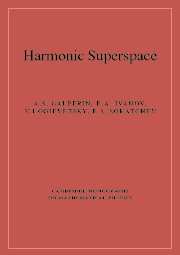Book contents
- Frontmatter
- Contents
- Preface
- 1 Introductory overview
- 2 Elements of supersymmetry
- 3 Superspace
- 4 Harmonic analysis
- 5 N = 2 matter with infinite sets of auxiliary fields
- 6 N = 2 matter multiplets with a finite number of auxiliary fields. N = 2 duality transformations
- 7 Supersymmetric Yang–Mills theories
- 8 Harmonic supergraphs
- 9 Conformal invariance in N = 2 harmonic superspace
- 10 Supergravity
- 11 Hyper-Kähler geometry in harmonic space
- 12 N = 3 supersymmetric Yang–Mills theory
- 13 Conclusions
- Appendix: Notations, conventions and useful formulas
- References
- Index
10 - Supergravity
Published online by Cambridge University Press: 24 August 2009
- Frontmatter
- Contents
- Preface
- 1 Introductory overview
- 2 Elements of supersymmetry
- 3 Superspace
- 4 Harmonic analysis
- 5 N = 2 matter with infinite sets of auxiliary fields
- 6 N = 2 matter multiplets with a finite number of auxiliary fields. N = 2 duality transformations
- 7 Supersymmetric Yang–Mills theories
- 8 Harmonic supergraphs
- 9 Conformal invariance in N = 2 harmonic superspace
- 10 Supergravity
- 11 Hyper-Kähler geometry in harmonic space
- 12 N = 3 supersymmetric Yang–Mills theory
- 13 Conclusions
- Appendix: Notations, conventions and useful formulas
- References
- Index
Summary
In this chapter we define the gauge group and prepotentials of conformal N = 2 supergravity in harmonic superspace. The gauge group is a local version of the analytic superspace realization of the rigid superconformal group SU (2, 2|2) discussed in Chapter 9. The prepotentials arise as the Grassmann analytic vielbeins covariantizing the harmonic derivative D++. Then we construct the harmonic superspace action of Einstein N = 2 supergravity. Its first basic ingredient is the action for a Maxwell compensating superfield in the background of conformal supergravity. As a second compensator we take a q+ hypermultiplet. This gives rise to an essentially new, ‘principal’ version of Einstein N = 2 supergravity. It contains an infinite number of auxiliary fields (coming from the q+ compensator) and is the only one allowing for the most general matter couplings. The previously known versions correspond to choosing as compensators N = 2 matter superfields with finite sets of auxiliary fields. They can be reduced to the principal version by duality transformations.
From conformal to Einstein gravity
In the formulation of supergravity we are going to follow the method of compensation of conformal supergravity [D17, D18, D21, K1, S7]. The idea of the method is to start with a graviton field belonging to an irreducible representation of the Poincaré group with spin 2 (conformal gravity).
- Type
- Chapter
- Information
- Harmonic Superspace , pp. 189 - 216Publisher: Cambridge University PressPrint publication year: 2001



